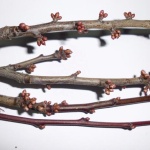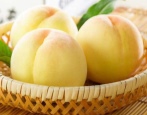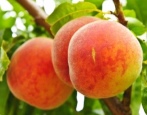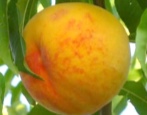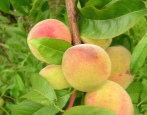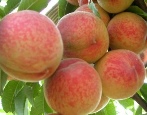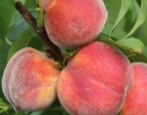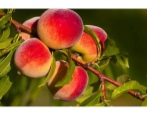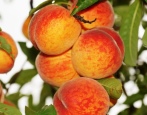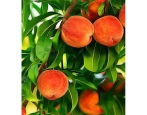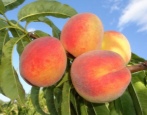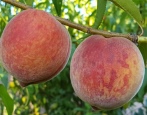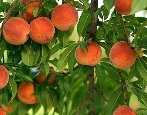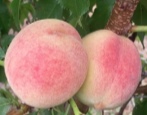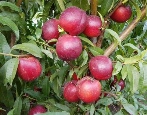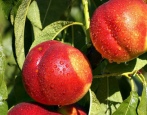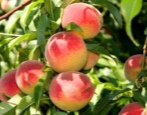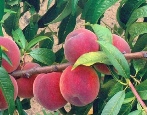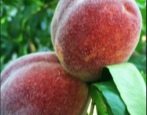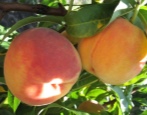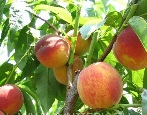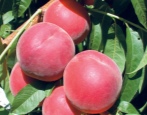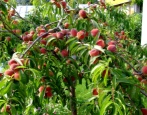
- Name synonyms: Big Hani
- Growth type: vigorous
- Self-fertility: partially self-fertile
- Appointment: for fresh consumption, for canning
- Transportability: good
- Separability of the bone from the pulp: not separable
- Winter hardiness: high
- Disease and pest resistance: high
- Fruit weight, g: up to 300
- Fruit color: yellow with a bright crimson blush
Growing a peach in a summer cottage or in the courtyard of a private house is the dream of every person. For cultivation, especially for beginners, it is worth choosing unpretentious varieties with good yields. These include the Big Hani peach - a representative of the world selection.
Description of the variety
Peach Big Hani is a vigorous tree with an average compact crown, growing up to 4 meters in height. The tree is endowed with moderate thickening with bright green lanceolate leaves, a strong trunk with brown bark and flexible greenish-brown branches.
Peach blooms in mid-spring (April). At this time, the fruit crop looks incredibly beautiful - bright pink flowers completely cover the crown, fragrant with a delicate aroma.
Fruit characteristics
Big Honey is a peach representing the medium fruit class. Under favorable conditions, fruits weighing 170-200 grams grow on the tree, and sometimes up to 300 grams. The fruit has a regular round shape with a pronounced abdominal seam. The ripe fruit has an uneven color - the yellow cover is diluted with a bright crimson blush that covers most of the peach. The peel of the fruit is of medium density, without edges and pronounced gloss.
Peaches are characterized by universal use - they are eaten fresh, used in cooking, canned, processed into drinks. After being removed from the tree, the fruit can be transported and stored without losing all qualities for 3-5 days. The softening of the peaches occurs gradually.
Taste qualities
The taste of the fruit is memorable - having tasted a peach once, you will definitely want to grow it in the country. The orange-yellow flesh has a tender, firm, moderately fleshy, fibrous and very juicy texture. The taste is dominated by bright sweetness with honey notes and a subtle spicy hint of acid. The skin of the fruit is not rigid. The bone is separated from the pulp very badly.
Ripening and fruiting
The variety is characterized by an average ripening period. The first harvest can be expected 3-4 years after planting. Fruits ripen gradually, so the ripening phase and the appearance of ripe fruits may take a little longer. Peach bears massive fruit from mid-August.
Yield
The yield indicator of the variety is good - it depends on the region of growth. In the southern regions, an average of 30 kg of sweet fruits can be removed from 1 tree per season, and in the northern part - 15-20 kg.
Self-fertility and the need for pollinators
This species is partially self-fertile, therefore, for maximum yield, it is recommended to plant donor trees with similar flowering periods. The peach tree-pollinator Polar Bear is considered the best for productivity.
Growing and care
Planting of seedlings is carried out in spring - from March to May, or in autumn - from September to November. Planting dates depend on the climate of the region. For planting, seedlings of 1-2 years old are purchased with a developed root system and even trunks, on which there are several branches and buds.
Agricultural technology consists of standard procedures - moistening, fertilizing, removing dry branches, loosening and mulching the soil, preventing diseases and preparing for winter.
It is recommended to water the tree 5-6 times during the growing season - the older the peach, the more abundant watering.Fertilizers should be applied three times a season - before the spring growing season, in the summer, when the fruits ripen, in the fall, when digging up the soil. Before winter, the trunk and branches are whitewashed, the peri-stem zone is mulched, the rhizome is insulated. Crown molding is carried out in the first 3 years after planting, and then sanitary pruning of the branches is carried out annually.
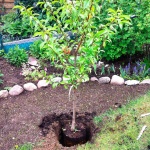
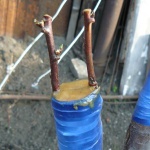
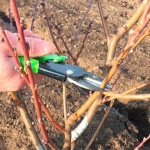
Frost resistance and the need for shelter
Winter resistance in the considered fruit crop is high, but the variety does not tolerate recurrent spring frosts - there is a partial shedding of flowers, which reduces the number of ovaries. In regions where it is up to -30 degrees in winter, there is no need to wrap the tree, just good mulching using sawdust or fallen leaves is enough. In regions with harsh winters, you will have to wrap the trunk and branches with sacking or agrofibre.
Disease and pest resistance
A good immune system is able to protect the tree from powdery mildew and curly foliage, but the culture is still exposed to some diseases. Most often, the peach tree suffers from clasterosporia and moniliosis. As for the invasion of pests, the plum moth, scale insect, aphid and striped moth are dangerous.
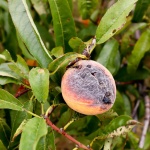
Requirements for soil and climatic conditions
For planting a peach, a place well-lit by the sun is selected, where there is protection from drafts and strong winds. The site must be flat, clean, with deep groundwater. Fluffy, fertilized, breathable and moist soil, endowed with a neutral acidity index, will be favorable for growth and development. The tree does not like prolonged shade and excess moisture, its stagnation.
